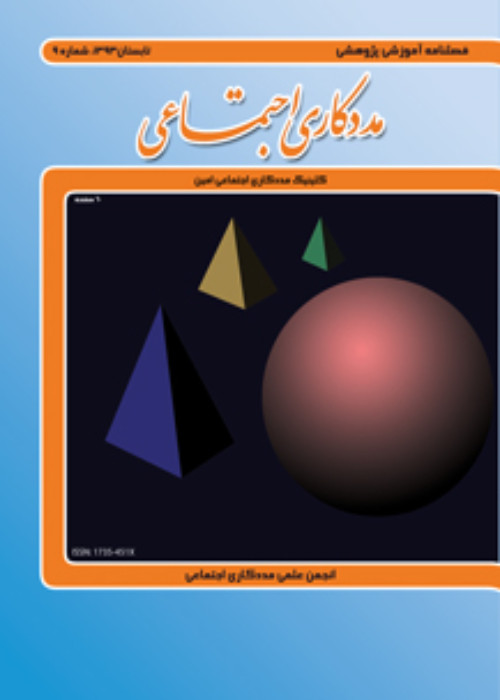فهرست مطالب

فصلنامه مددکاری اجتماعی
سال چهارم شماره 13 (پاییز 1394)
- تاریخ انتشار: 1394/08/24
- تعداد عناوین: 4
-
صفحات 5-17مقدمهسلامت اجتماعی به عنوان تلقی افراد از کیفیت رابطه شان با دیگران، همنوعان و اجتماع اطراف تعریف و از شاخص های کیفیت زندگی محسوب می شود. این مطالعه بر آن است تا ضمن تعیین وضعیت سلامت اجتماعی زنان و مردان جوان، به بررسی نقش سرمایه اجتماعی خانواده در این زمینه بپردازد.روشپژوهش حاضر، بر روی نمونه ی جامعه آماری به حجم 384 نفراز جوانان هیجده تا بیست و نه ساله ی شهر تبریز با روش پیمایش، تکنیک پرسشنامه و روش نمونه گیری خوشه ایانجام شده است.نتایجیافته ها حاکی از آن است که سلامت اجتماعی پاسخگویان با میانگین 65/58 (در دامنه 100-0) بالاتر از حد متوسط می باشد. بین سرمایه اجتماعی خانواده (سرمایه اجتماعی درونی، بیرونی) با سلامت اجتماعی جوانان رابطه معنادار و مستقیم وجود دارد. همچنین، از میان متغیرهای زمینه ای نیز بین مقطع تحصیلی با سلامت اجتماعی فرد رابطه معنادار وجود دارد. در نهایت، بر اساس نتایج تحلیل رگرسیون متغیرهای این پژوهش، 9/35 درصد از واریانس سلامت اجتماعی جوانان را تبیین می کنند.بحث و نتیجه گیریمی توان گفت سرمایه اجتماعی خانواده باعث ارتقای سلامت اجتماعی جوانان می شود.کلیدواژگان: سرمایه اجتماعی، سلامت اجتماعی، کیفیت زندگی
-
صفحات 18-27مقدمهاسترس یکی از مهم ترین مشکلاتی است که جوامع در عصر حاضر با آن مواجه هستند که پیامدهای جسمی، روانی و اجتماعی به همراه دارد. از نظر سلیه استرس پاسخ غیر اختصاصی بدن به هرگونه فشاری است که بر آن وارد می شود. مهارت های مقابله با استرس کوشش های رفتاری، شناختی، روانی هستند که افراد برای مقابله با استرس و کاهش دادن آن انجام می دهند.روشاین مطالعه به روش مروری انجام شده است. مهم ترین پایگاه های اطلاع رسانی فارسی، با 16 کلید واژه ی فارسی و در بازه ی زمانی سال های 1380 تا 1394 و مهم ترین پایگاه های اطلاع رسانی لاتین با 9 کلید واژه ی لاتین و در بازه ی زمانی سال های 2000 تا 2011 جست وجو شد. از مجموع اطلاعات به دست آمده در نهایت 62 سند باقی ماند که کیفیت آن توسط سه نفر از اعضای تیم مورد تایید قرار گرفت و وارد فرآیند تجزیه و تحلیل نهایی شدند.نتایجروش های بیوفیدبک، تصویرسازی ذهنی هدایت شده، تنفس دیافراگی، کاهش استرس مبتنی بر ذهن آگاهی، درمان شناختی-رفتاری، آرام سازی عضلانی پیشرونده از جمله برخی از موثرین تکنیک ها در کاهش استرس به شمار می آیند و در گروه های مختلف اثربخشی متفاوت دارند.بحث و نتیجه گیریآموزش و بکار گرفتن تکنیک های مقابله با استرس در گروه های بیمار و سالم جامعه توسط کارگزاران بخش سلامت از جمله مددکاران اجتماعی امکان پذیر است و موجب ارتقاء سلامت عمومی جامعه می شود.کلیدواژگان: استرس، مقابله با استرس، سلامت، مدیریت استرس
-
صفحات 28-36مقدمهاین پژوهش با هدف بررسی تاثیر آموزش مهارت های زندگی بر خودکارآمدی و عملکرد خانواده زنان سرپرست خانوار انجام شده است.روشاین پژوهش نیمه آزمایشی با طرح پیش آزمون و پس آزمون با گروه های آزمایش و کنترل اجرا شد. جامعه آماری این پژوهش کلیه زنان سرپرست خانوار شهر ورامین در سال هزارو سیصذ نود چهاربودند. از میان آنان 40 زن با روش نمونه گیری در دسترس انتخاب و به طور تصادفی در دو گروه (هر گروه 20 نفر) جایگزین شدند. گروه آزمایش 10 جلسه 70 دقیقه ای با روش مهارت های زندگی آموزش دید اما گروه کنترل هیچ آموزشی دریافت نکرد. پرسشنامه های خودکارآمدی و عملکرد خانواده در مراحل پیش آزمون و پس آزمون از هر دو گروه تکمیل کردید. داده ها با روش تحلیل کوواریانس چندمتغیری و به کمک نرم افزار SPSS19 موردتجزیه و تحلیل قرارگرفت.نتایجنتایج نشان داد که بین گروه آموزش و گروه کنترل در متغیرهای خودکارآمدی و عملکرد خانواده تفاوت معناداری وجود دارد. به عبارت دیگر آموزش مهارت های زندگی باعث بهبود معنادار خودکارآمدی و عملکرد خانواده در زنان سرپرست خانوار شده است (P< 0/01).بحث و نتیجه گیریبا توجه به نتایج این پژوهش پیشنهاد می شود از روش آموزش مهارت های زندگی برای بهبود خودکارآمدی و عملکرد خانواده زنان سرپرست خانوار استفاده شود.کلیدواژگان: مهارت های زندگی، خودکارآمدی، عملکرد خانواده، زنان سرپرست خانوار
-
صفحات 37-43مقدمهمطالعات بسیاری به بررسی سلامت روان ورزشکاران و غیر ورزشکاران پرداخته اند اما اطلاعات محدودی در زمینه سلامت روان افراد معلول حسی ورزشکار و غیر ورزشکار وجود دارد، بنابراین هدف از تحقیق حاضر مقایسه سلامت روان افراد معلول حسی ورزشکار و غیر ورزشکار بود.روش120 معلول حسی شهر تهران 30 نفر نابینای ورزشکار، 30 نفر نابینای غیر ورزشکار، 30 نفر ناشنوا ورزشکار و 30 نفر ناشنوای غیرورزشکاربا روش نمونه گیری در دسترس انتخاب شدند. از پرسشنامه GHQ-28 که شامل 4 خرده مقیاس است برای سنجش سلامت روان استفاده شد. برای تجزیه و تحلیل نتایج از آزمون یو من ویتنی استفاده گردید.نتایجیافته های تحقیق حاضر نشان می دهد که افراد معلول حسی ورزشکار نسبت به همتایان حسی غیر ورزشکار خود به طور معنی داری امتیاز بالاتری در پرسشنامه GHQ-28 به دست آوردند. تفاوت معناداری بین دو گروه در خرده مقیاس های سلامت جسمانی، اضطراب و بی خوابی و افسردگی مشاهده شد. ولی در خرده مقیاس کارکرد اجتماعی بین دوگروه تفاوت معناداری نشان داده نشد.بحث و نتیجه گیریبا توجه به نتایج تحقیق می توان نتیجه گیری کرد که ورزش و فعالیت جسمانی می تواند سلامت روان افراد معلول حسی را بهبود بخشد. فعالیت بدنی سبب می شود تا آن ها از طریق ورزش اعتماد به نفس و سلامت روان بهتری بدست آورند و با روحیه بهتری جهت انجام کارهای روزانه و شحصی خود در جامعه حضور داشته باشند.کلیدواژگان: سلامت روان، معلول حسی، ورزشکار، غیر ورزشکار
-
Pages 5-17Introductionwell-being defines as the assessment of the ones relationship with others, fellows and his/her community around and as such it can be considered as an important measure of life quality.This study tries it assess the social well-being of youth women and men to explore the role of family social capital in the form of this deal.MethodThis study, basedona validsamplepopulation of384individualsyouth18-29 years oldin Tabrizby surveyquestionnaire andcluster samplingtechniquewas conducted.ResultsThe results indicate that social well-being of participants with an average 58/65,(0-100 range),percent is above average. The results show that there is a meaningful and direct relation between family social capital and its dimensions (social capital within and beyond the family) whit youths social well-being.Also, among field variables, there is a meaningful relation between ones education and social well-being. Finally, According to the regression analysis, the variables of this dissertation specify 35/9 percent of the youths social well-being variance.ConclusionAs predicted , family social capital improves youths social wellbeing.Keywords: Social Capital, Social Well, Being, Quality of Life
-
Pages 18-27IntroductionStress is among the most problems in front of societies in the present time and affects physical, mental and social health of people. Stress according to Selye is any nonspecific response of the body to any demand for change. Stress coping methods are behavioral, cognitive and psychological efforts to deal with stress.MethodsThis study is conducted in review method. Data collected based on Persian and English data bases, according to 16 Persian keywords and 9 Latin keywords in the period of 2000 to 2011. Sixty two documents remained in the assessment of the study after approving the quality by three members of the research team was approved and entered into the final analysis processResultsBiofeedback, Guided Imagery, Diaphragmatic Breathing, Mindfulness-Based Stress Reduction, Cognitive Behavioral Therapy and Progressive Muscle Relaxation are among the most effective techniques of reducing stress and have different effectiveness in various groups.ConclusionsUsing stress management techniques which are easy to learn and practice in health or disease population by health practitioners such as social workers are led to enhance public health in society.Keywords: stress, coping with stress, health, stress management
-
Pages 28-36IntroductionThis research aimed to investigate the effect of life skills training on self-efficacy and family function in women headed households.MethodsThis research was a queasy-experimental with a pre-test and post-test design with an experimental and control groups. The statistical population included all women headed households of Varamin city in 2015. Forty women were selected by available sampling method and randomly assigned to two groups (each group contain 20 person). The experimental group received 10 sessions of 70 minutes educated by life skills training and control group dont receive any training. The groups completed the questionnaire of self-efficacy and family function as a pre-test and post-test. The data were analyzed by multivariate analysis of covariance method with using of SPSS-19 software.ResultsThe results showed there was significant difference between life skills training group and control group on variables of self-efficacy and family function. On the other hand life skills training led to significant increase self-efficacy and family function of women headed households (PConclusionsRegarded to results of this research suggest that counselors, therapists and clinical psychologist can use life skills training method for improving self-efficacy and family function of women headed households.Keywords: Life Skills, Self, Efficacy, Family Function, Women Headed Households
-
Pages 37-43IntroductionSeveral studies examined the mental health of athletes and non-athletes, However, There are limited information on the mental health of athletes and non-athletes with sensory disabilities. So, the aim of this study was to compare the mental health of athletes and non-athletes with sensory disabilities.MethodsThe sample population was 120 (30 blind athlete, 30 blind non-athletes, 30 deaf athlete and 30 deaf non-athletes) male sensory disabled people from the city of Tehran, who were selected by Convenience sampling.The measuring instrument of the study was GHQ-28 Questionnaire (MHQ) which includes 4 sub-scales of mental health. The collected data were analyzed using Manvitney U test and T-student test.ResultsThe results of the study indicated that there is a significant difference between mental health and sub-scales of somatic symptoms, anxiety and insomnia and severe depression in athletes and non-athletes sensory disabled people (pConclusionsThe results of this study indicated that the mental health of the sensory disabled athletes people were better than those of the sensory disabled non-athletes. Therefore it seems necessary that sports and physical activities be more attended in the daily schedule of disabled people.Keywords: Mental Health, Sensory Disabilities, Athletes, Non, Athletes


